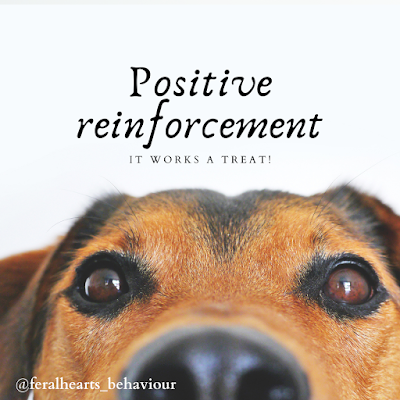Positive reinforcement (+R) - what is it and why use it?
Positive reinforcement (often abbreviated as +R or R+) is one of 4 quadrants associated with classical conditioning within the field of behaviourism. Rather than positive meaning 'good' it is used in the terms of scientific reference, and means 'addition'. To make this clearer some people will refer to it as 'Added reinforcement' because it mean s that we are adding something to the environment, rather than taking it away.
The 'reinforcement' part means that it reinforces a behaviour, and when utilised it will encourage those receiving the positive reinforcement to perform the behaviour they are being reinforced for more frequently.
Positive reinforcement, while not innately 'positive' in itself, does require the reinforcer to be something that the animal finds pleasant or desirable/pleasant - There are several primary reinforcers that all animals will find reinforcing such as:
- Food
- Water
- Play
- Affection / Companionship
- Access to shelter
- Mating/reproduction
When it comes to teaching our animals new skills food, play and affection are the key resources and reinforcers to utilise. Which we chose to work with will depend both on the species, and the individual in front of us, in the environment that we're in at the time. It is uncommon for 1 reinforcer to work in every context, you're more likely to end up having a 'tool box' of different reinforcement that you can use in different situations where appropriate. Such as using hot dog to teach your dog tricks as enrichment, or a tug toy for at the end of an agility run, but using dry biscuits for cooperative care at home where you want to set a more relaxed tone. For horses this may involve using scratches for cooperative care, while using sliced carrot to train move difficult movements where you need them to be more physically engaged.
Here it is worth pointing out that when we use the quadrants negative reinforcement where something the animal dislikes is introduced and the later removed to create 'relief' or positive punishment where something the animal finds unpleasant is added we are using the primary reinforcers that are:
- Discomfort
- Pain
- Fear
Additionally, with negative punishment, we are taking away something the animal finds pleasant and this can often lead to unpleasant affective states such as frustration or rage.
Positive reinforcement is not synonymous with giving an animal a positive emotional and learning experience, if the training situation is not set up appropriately, if timing of reinforcers aren't accurate and if the value of the reinforcement is too high then it can lead to frustration, tension and but when compared to the other options within the classical conditioning approach, it is by far, at present, with the science that we have available, the best option when we want to consider the animal emotional experience and the effectiveness of their learning.
Some of the benefits to using positive reinforcement to teach your animal new skills / behaviours:
- It helps builds confidence in your animal.
- It allows you to teach them by clearly asking them what you'd like them to do, then celebrating when they get it right, rather than always nagging them if you perceive them as getting it 'wrong'.
- It makes learning fun for all the family.
- It allows your animal to have autonomy and get creative in what they offer.
- It prevents learnt helplessness when used as your only (and often primary) teaching method.
- It allows your animal to still express their calming and stress signals, which gives you a clearer understanding of their emotional experience - meaning you can often deal with any issues that arise sooner before it becomes such a deep rooted problem.
- It is a way to teach skills (such as cooperative care) which are essential to your animals health and wellbeing, while ensuring that they don't feel dis-empowered. This can help everyone stay safer than with an animal who didn't feel comfortable with care procedures.
- Animals taught with positive reinforcement are often more engaged and eager to participate in interactions.
- Studies have shown that positive reinforcement training, in place of using the other quadrants, shows a significant reduction in anxious, aggressive and fearful behaviours.
- The above suggests that positive reinforcement learning typically helps the learner feel more safe and secure than with the other quadrants.
- Those who train with +R report having fewer problems with their animals behaviour (Study done on dogs).
- Positive reinforcement helps maintain a positive relationship with your animal, and develop trust.
Of course classical conditioning is about just that, conditioning, and does not replace the animals requirements for their needs being met, and to feel safe and secure. Nor does it build relationship. But it does allow us to teach the animals in our care how to cope with the human-centric world that they are forced to live in, and can help them navigate their lives with us so that they thrive. Should everything be about training? Absolutely not. But when we do need to teach a skill then, where possible, positive reinforcement is definitely the way to go.
🐾🐾🐾🐾🐾
Jenny Barker 2021©
https://www.feralhearts-horses.com/


